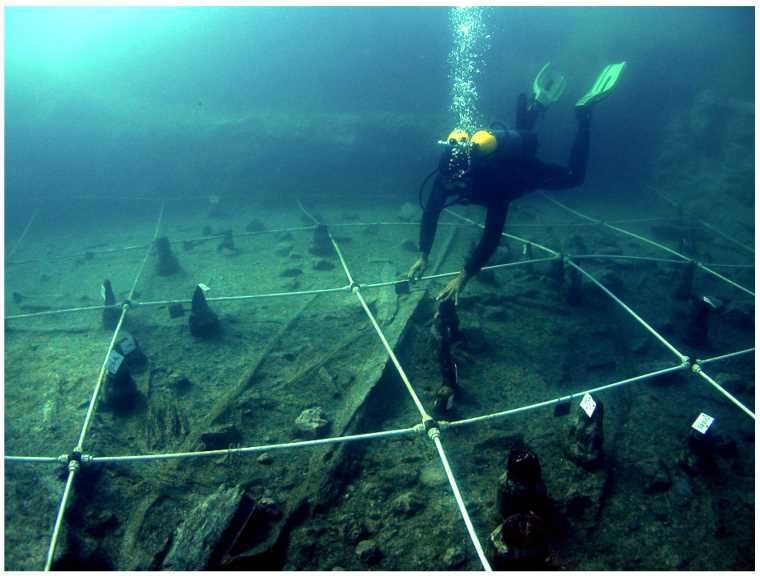According to an analysis published in the journal PLOS ONE, the ancient seafaring vessels discovered at the site are the oldest ever found in the Mediterranean, which may offer “invaluable insights” into the technological sophistication employed by Neolithic navigators.
“Direct dating of Neolithic canoes from La Marmotta reveals them to be the oldest in the Mediterranean, offering invaluable insights into Neolithic navigation,” the researchers explain. “This study reveals the amazing technological sophistication of early agricultural and pastoral communities, highlighting their woodworking skills and the construction of complex vessels.”
Ancient Canoes Contain Evidence of Advanced Nautical Technology
According to the researchers, they found five dugout canoes in the ancient lakeshore village of La Marmotta near the coast of Rome, Italy, dating from 5,700-5,100 B.C. While they already knew that ancient seafarers traded throughout the Mediterranean, the dugout canoes revealed signs of advanced nautical technology not previously found in Stone Age vessels.
For example, the boats contain what the researchers describe as “advanced construction techniques,” including transverse reinforcements. The researchers behind the unique find say these advanced construction elements “would have increased the durability of the hull and protected it, as well as improving its handling.”
One of the canoes also contained the remains of three t-shaped wooden objects that had a series of holes in them. In more modern vessels, such devices are used to fasten and operate sails.


“The characteristics and position of these objects suggest that they might have been used to fasten ropes tied to a possible sail or to join other nautical elements such as a stabiliser or even another boat to create a double hull in the form of a catamaran> the researchers write. “Those strategies would have provided greater safety and stability, and greater capacity for the transport of people, animals and goods.”
The canoes are also made from four different types of wood, something the researchers said was particularly unusual for this time period and location. Combined with the other elements, the canoes represent examples of advanced nautical technology date that was capable of traveling across the Mediterranean Sea.
“These features, along with previous reconstruction experiments, indicate these were seaworthy vessels, a conclusion supported by the presence at the site of stone tools linked to nearby islands,” the researchers explain in a press release announcing the finds.
Advanced Sailing Vessels Could Rewrite Ancient History
As noted, previous discoveries in the area seemed to support some level of nautical navigation by Stone Age peoples. However, these new excavations offer the most compelling, direct evidence that they used advanced nautical technology much earlier than previously thought.
“Similarities between these canoes and more recent nautical technologies support the idea that many major advances in sailing were made during the early Neolithic,” the press release explains.


Study author Juan F. Gibaja of the Spanish National Research Council and colleagues believe that the unexpected findings could help to rewrite the history of the area and its people.
“Navigation in the Mediterranean in the Neolithic is studied here through the boats that were used, the degree of technical specialization in their construction, and, above all, their chronology,” they explain. “This will allow a reflection on the capability of Neolithic societies for navigation owing to their high technological level. This technology was an essential part in the success of their expansion, bearing in mind that in a few millennia, they occupied the whole Mediterranean from Cyprus to the Atlantic seaboard of the Iberian Peninsula.”
Notably, the researchers point out that much of the archaeological evidence from this time has been lost due to erosion or even bacterial degradation. However, the site at La Marmotta was exceptionally well-preserved. That’s mainly because the ancient village is about 300 meters from the modern shoreline and under eight meters of water. The remains of the village also lie under three meters of sediment, something they describe as “a natural form of protection, safely under water and earth.”
Along with the five canoes, various excavations at the site dating back to 1989 have found evidence of a surprisingly advanced community, including the domestication of sheep, goats, and other livestock. Combined with the advanced nautical technology evidenced by the canoes, the researchers say this is all evidence supporting a village with “a fully consolidated domestic economy.”
More Boats at La Marmotta May Offer More Evidence of Advanced Nautical Technology
Moving forward, Gibaja and colleagues say there may be more boats hidden beneath the sediments of La Marmotta, which could be a “potential avenue for future research.”


“We believe that there may be a larger number of boats still preserved under the waters of Lake Bracciano, and it is possible that they could be excavated in the future,” they explain.
Still, the researchers behind the discovery note that the ancient construction dates of the findings already made are significant. In fact, they say the canoes themselves are “exceptional examples of prehistoric boats” and that their construction and operation required “a detailed understanding of structural design and wood properties in addition to well-organized specialized labor.”
“These canoes at La Marmotta, and the occupation of many islands in the eastern and central Mediterranean during the Mesolithic and particularly the early Neolithic periods, are irrefutable proof of the ability of those societies to travel across the water,” the researchers conclude. “The Marmotta canoes are not only outstanding evidence of how they achieved that but also an example of the complexity of those societies from the viewpoint of their social and technical organization.”
Christopher Plain is a Science Fiction and Fantasy novelist and Head Science Writer at The Debrief. Follow and connect with him on X, learn about his books at plainfiction.com, or email him directly at christopher@thedebrief.org.

